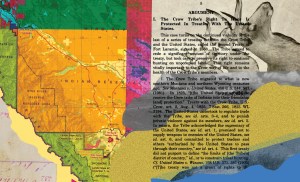Along the eastern foothills of Wyoming’s Absaroka Mountains, halfway between Crowheart and Dubois, a weathered buck-and-rail fence separates tribal land from public land. To the east lies the Wind River Reservation and the jurisdiction of tribal game warden Justin Friday. On a clear fall morning in 2020, Friday’s ATV zipped along a dusty two-track on the national forest side of the fence.
It had been a hot, dry summer. The East Fork of the Wind River was a narrow band of green, snaking through tangles of sagebrush and bunchgrass that, a few miles up, gave way to towering lodgepole forest.
“Up here is the reservation boundary,” Friday shouted over the engine. A sign on the tribal side read: WIND RIVER INDIAN RESERVATION CLOSED TO HUNTING, FISHING, TRAPPING AND TRESPASSING.
Friday was retracing the path of Matthew Harris, who would have hiked past the sign in October 2017. Harris, a special agent with the U.S. Bureau of Alcohol, Tobacco, Firearms and Explosives, worked at the agency’s satellite office in Lander and was out that day hunting.
Friday parked and hiked a short way uphill, over a break in the fence where wildlife often crossed. In a clearing, he found what was left of Harris’ kill after three years: the sun-bleached skeletal remains of a bull elk. Most of the animal’s ribcage and two femurs remained, but the skull and antlers — the parts a hunter might take to display at home — were gone.
According to the Shoshone and Arapaho Fish and Game Code, only Eastern Shoshone and Northern Arapaho tribal citizens with the proper permits and tags may hunt on the reservation. Harris met none of those requirements when, according to federal investigative reports obtained by High Country News, he aimed his .338 caliber rifle across the fence and fired twice at some elk.
If this story sounds familiar — a law enforcement officer downing an elk on the wrong side of the border between tribal land and a national forest in Wyoming — you’re probably thinking of Clayvin Herrera, a former Crow tribal game warden who made headlines asserting the tribe’s treaty right to hunt on the “unoccupied land of the United States.”
Herrera was convicted of two misdemeanors for shooting elk in the Bighorn National Forest in 2014. The resulting legal battle went all the way to the U.S. Supreme Court, which, in 2019, decided in Herrera’s favor, a landmark decision affirming the tribe’s off-reservation hunting rights in Wyoming. (In early 2021, Herrera was charged with other offenses unrelated to poaching.)
Eight years later, however, Wyoming is still working to uphold Herrera’s original convictions.
Harris’ alleged crime — the mirror image of Herrera’s — never received comparable attention. Despite physical evidence and an eyewitness account, state and federal attorneys declined to prosecute. And, as of late March, Harris was still employed by the ATF, a federal agency that investigates crimes involving firearms.
A FEW WEEKS AFTER REVISITING the elk bones, Friday pulled over two white men in a red truck hauling an ATV, following a tip about non-Natives driving along a mountain road reserved for tribal members. Body camera footage shows Friday lowering the volume on a talk radio show, getting out of his truck and greeting them.
“You guys are on the reservation,” Friday told them. “You’re trespassing.”
“Bullshit,” the man in the passenger seat replied. “I’m not putting up with this shit.”
Friday called this response “typical” of his interactions with white Wyomingites. Out-of-staters speak to him in the way you’d expect: Yes sir, thank you sir, we’ll get out of here right away. But locals can get belligerent even before he explains what they’ve done wrong. He thinks being confronted by a Native person in a position of authority makes them upset.
“If one of my guys is patrolling out on the East Fork and he gets a call about someone on the other side of the mountain, it’s gonna take him five hours to get over there, minimum. We’re not going to catch everybody.”
Art Lawson, director of Shoshone and Arapaho Fish and Game
“I know the law way better than you do, and we’re gonna leave,” the passenger said, leaning toward Friday and pointing in the direction they were already headed. “The fuck are you gonna do?”
Stops like this one, often prompted by tips from tribal hunters, are one of the department’s tools for catching trespassers and poachers. So are trail cameras, placed strategically near the reservation’s borders, where they might photograph a poacher’s face or license plate number — anything that might merit an investigation and, eventually, prosecution. Friday suspected that non-Natives trespassed almost daily on the reservation during hunting season, and the cameras and tribal hunters’ accounts appeared to confirm this.
“Most of the people doing this, they’re repeat offenders,” he said. “Every year, we get tribal members reporting the same names consistently.”
Sometimes, in violation of the game code, a Shoshone or Arapaho hunter brings a non-Native friend along on a hunting trip. More often, though, Friday said, the poachers come on their own. Most are lifelong hunters from Dubois, Lander or Thermopolis who aren’t satisfied with the hunting tags they’ve drawn.
Friday and his boss, Art Lawson, archive poaching evidence at the Shoshone and Arapaho Fish and Game Department office, a one-story building tucked behind the grocery store in Fort Washakie. It’s about two hours from the East Fork area and about the same distance in the opposite direction from the other poaching hotspots. Lawson’s department is tasked with patrolling the land, checking hunters’ permits, and compiling evidence to refer cases for prosecution. But he said the agency is underfunded and understaffed, with, at most, three wardens responsible for 2.2. million acres, an area the size of Yellowstone National Park.
“But if one of my guys is patrolling out on the East Fork and he gets a call about someone on the other side of the mountain, it’s gonna take him five hours to get over there, minimum,” Lawson said. “We’re not going to catch everybody.”
Even when poachers are caught in the act, prosecution isn’t easy. In 1978, the U.S. Supreme Court stripped tribal courts of jurisdiction over non-Indians who commit crimes on tribal lands, leaving federal authorities to prosecute such offenses in most cases.
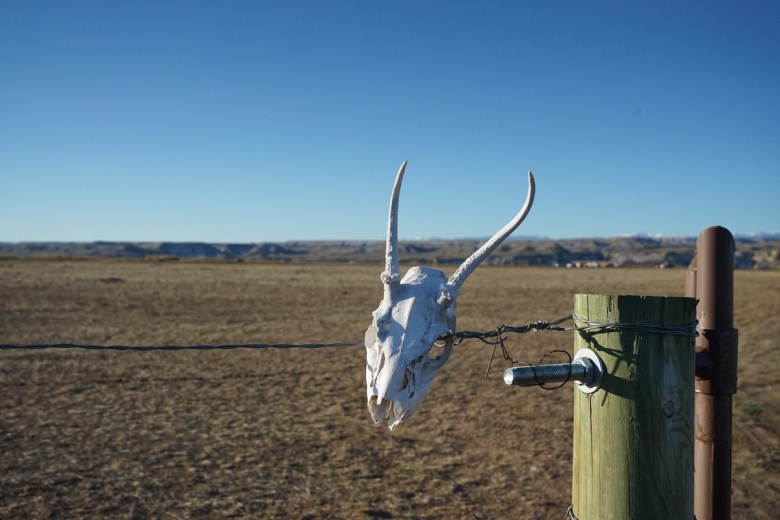 A skull adorns the fencepost near the Eastern Shoshone’s buffalo management land on the Wind River Indian Reservation. (Katie Klingsporn/wyomingdigest.com)
A skull adorns the fencepost near the Eastern Shoshone’s buffalo management land on the Wind River Indian Reservation. (Katie Klingsporn/wyomingdigest.com)
At the office, Lawson and Friday thumbed through the case files of habitual poachers: investigative notes, blurry cellphone photos from tribal hunters and grainy trail-camera stills. In one set of black-and-white images, Friday pointed out what might have been an animal’s body in the back of a pickup.
“There’s an elk horn, a bull elk, on the back of the flatbed,” Friday said. But the photo was taken at night, so it’s hard to be sure, and the federal attorneys in Cheyenne chose not to prosecute.
Given their lack of resources, Lawson and Friday said they rarely build a strong-enough case to send to the U.S. attorney’s office; the handful of cases they’ve referred have been dismissed for lack of evidence. Tribal fish and game and the U.S. attorney’s office agree that the gold standard for prosecution is an eyewitness account combined with physical evidence. Lawson and Friday felt they had both in the Harris case, and that’s what made the outcome such a blow.
“We had an eyewitness who actually stepped forward and said, ‘Hey, I saw this guy poach on the reservation. I know where the elk is. I know where the shell casings are,’” Friday said. “We just don’t get that normally.”
BEFORE DAWN ON OCT. 7, 2017, Harris and Michael Kowach, his hunting partner, left Lander for the East Fork area. Kowach is a local who, according to a report prepared by the U.S. Fish and Wildlife Service, met Harris while working as an informant for the ATF’s Lander office on a firearms trafficking case. Reached by phone, Kowach said that Harris, who had moved to Lander from Wilmington, North Carolina, was excited about hunting in Wyoming. (Type Investigations and HCN repeatedly attempted to contact Harris for comment; he did not respond.)
“From the impression I got, he was a novice hunter from back East,” Kowach said. “He’d hunted whitetails every once in a while, but as everybody knows, hunting back East sucks.”
Kowach, who was born and raised in Wyoming, speaks with brusque authority about hunting regulations and the best tag zones, where you can find “piles” of elk or mule deer, though patience and skill are still needed to bag one.
When Harris called Kowach for help filling an elk tag in the East Fork area, Kowach agreed and used GPS to ensure they didn’t accidentally cross over onto reservation land. The buck-and-rail fence was also there to mark the boundary.
Before long, they spotted a herd of elk on the tribal side, including two bulls that Kowach calls “absolute monsters,” meandering down the slope toward a break in the fence.
The two men tell different stories about what happened next. Kowach said he told Harris to just sit tight; eventually, the elk would wander over onto national forest land. But, according to Kowach, Harris took off running toward the elk. Kowach told Type Investigations and HCN that he didn’t see Harris pull the trigger; he only heard the gunshots. But once he caught up with him, he saw one of those monster bull elk, wounded and bleeding out of its side.
By Kowach’s account, Harris was in the national forest when he shot. The elk, however, were on the reservation.
In interviews with federal, state and tribal investigators, Harris didn’t deny shooting the elk. Instead, he said that Kowach goaded him into shooting, and he pleaded ignorance of the reservation boundary’s location.
“Harris reasoned that fences in Wyoming do not always mean boundaries; they could be found through the middle of public lands dividing a cattle pasture,” a Department of Justice investigator wrote in his report. But the investigator also found that Harris “lacked candor” regarding his knowledge of the boundary.
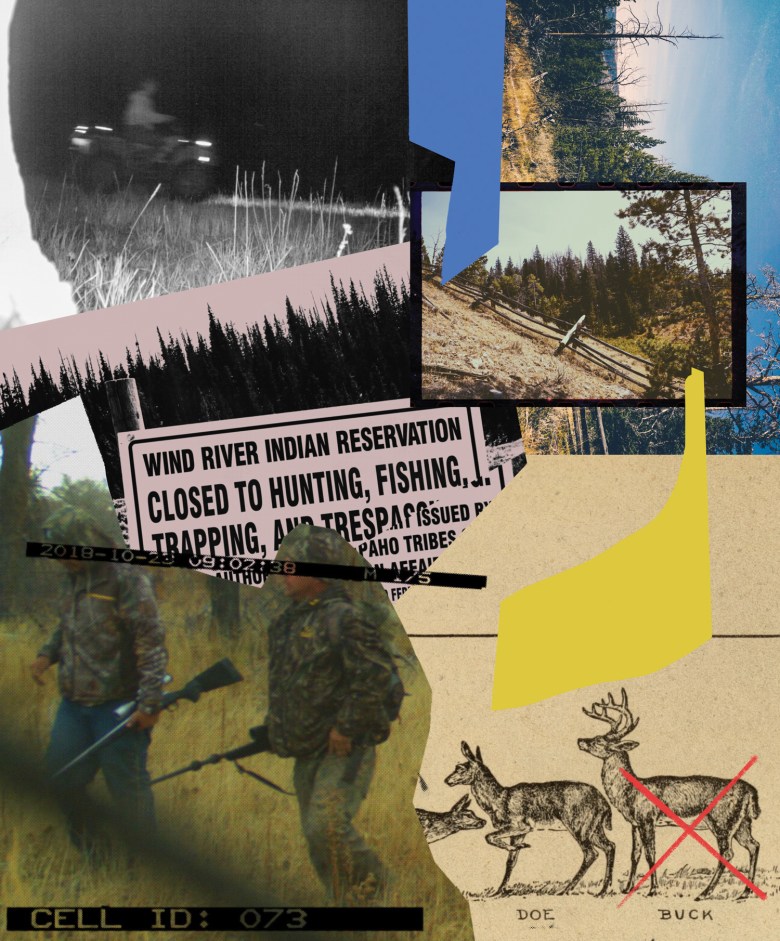 (Neu Tokyo/High Country News)
(Neu Tokyo/High Country News)
When Kowach told Harris that the elk he shot was on what he called “Indian land,” Harris said he experienced a “blur of panic.”
“Oh, it was heated.” Kowach said. By Kowach’s account, he insisted that Harris finish off the elk and turn himself in. While they argued, the wounded animal ran deeper into tribal forest.
“He was freaking out. ‘Don’t report me, don’t turn us in, don’t do this, don’t do that.’”
But Kowach felt he had to turn Harris in; he was friends with state game wardens and, according to federal investigative reports, had tipped off the department about previous wildlife crimes, sometimes helping the department catch violators in the act.
Kowach said he gave Harris a deadline to turn himself in. After three days, when Harris didn’t act, Kowach called the department himself, which contacted Lawson and Friday’s department in turn. But tribal Fish and Game couldn’t simply take over the case: Since Harris was non-Indian, tribal authorities lacked criminal jurisdiction. So they brought in an agent with the U.S. Fish and Wildlife Service. Because Harris was a federal cop, the Justice Department’s Office of the Inspector General also conducted a parallel investigation at the ATF’s request.
A couple of weeks later, Kowach was interviewed by investigators from all four agencies. It was already late October, and snow covered the road to the East Fork. Friday feared that by the time it was passable, any evidence would be lost. Still, the following spring, Kowach led investigators along the two-track, past the boundary sign and up the mountainside to the shooting scene, where they found two spent cartridge casings that matched Harris’ rifle. A few hundred yards into the reservation, they found the remains of an elk.
THE QUESTION OF WHO GETS TO HUNT in the area has been fraught since white settlers arrived in what is now Jackson in the late 1800s. Elk populations dwindled as homesteads increased. Meanwhile, the displaced Indigenous people continued to subsistence hunt in the area, as their treaty rights allowed and as their ancestors had done for thousands of years.
But in July 1895, hunters from the Bannock Tribe awoke to find their camp surrounded by 27 armed white men, there to arrest them for hunting outside of Wyoming’s recently imposed elk season. The Bannock party surrendered their weapons but, fearing for their safety, fled during the march to town. In the fray, an infant was swept off his mother’s back and was never found. The homesteaders shot an unarmed Bannock elder four times in the back, and the surviving elk hunters raced back to Fort Hall. But a telegram from one white Jackson official to Wyoming’s governor told a different story: “Many Indians reported here: threaten lives and property. Settlers are moving their families away. Want protection immediately. Action on your part is absolutely necessary.” Wyoming newspapers and others across the country falsely claimed that the Bannock party had massacred dozens of white families in Jackson.
“The state of Wyoming is making superficial arguments to try to bring forward outdated rulings.”
Angelique EagleWoman (Dakota), director of the Native American Law and Sovereignty Institute at the Mitchell Hamline School of Law
The incident triggered a legal test case of the Shoshone-Bannock Tribes’ off-reservation hunting rights. Ward v. Race Horse went to the Supreme Court, which in 1896 ruled that tribal treaty rights to hunt in the region had been nullified six years earlier, when Wyoming became a state.
For more than a century, Western states including Wyoming used Ward v. Race Horse to arrest Indigenous people exercising their off-reservation hunting rights, with federal courts reaffirming it as recently as the 1990s. But in 2019, faced with Clayvin Herrera’s case, the Supreme Court agreed to reconsider it.
Heather Whiteman Runs Him (Crow), an attorney who helped defend Herrera before the court, said the stakes were high for Crow people, whose ancestral relationship to the Bighorn Mountains had been severed by Race Horse. The mountains, she said, are “absolutely pivotal to our worldview as Apsáalooke people.”
“There are a lot of people in our community who have believed in the ongoing viability of our treaty rights for their whole lives,” she said. “And people who have sought to exercise those rights and done so at the risk of being prosecuted because they believe in the rights that our ancestors insisted on.”
In 2019, the High Court ruled in Herrera’s favor. Whiteman Runs Him called the decision monumental — “a fundamental step in beginning to restore and rebuild the relationship to the land.”
For Indian Country, Herrera was a hard-won affirmation of perhaps the most important principle of Indian law: that treaties between tribal nations and the federal government are, as the U.S. Constitution declares, “the supreme law of the land.” Treaties can only be abrogated or repealed by an act of Congress — not piecemeal by states that disagree with their provisions.
In its decision, the Supreme Court instructed lower courts to reconsider Herrera’s convictions by answering two questions: Is the Bighorn National Forest “unoccupied” for the purposes of the treaty right, and are there conservation reasons to limit treaty hunting there?
But three years after Herrera, it’s not clear that treaty hunters in Wyoming are any safer from prosecution than the Bannock party was in 1895, or Herrera in 2014.
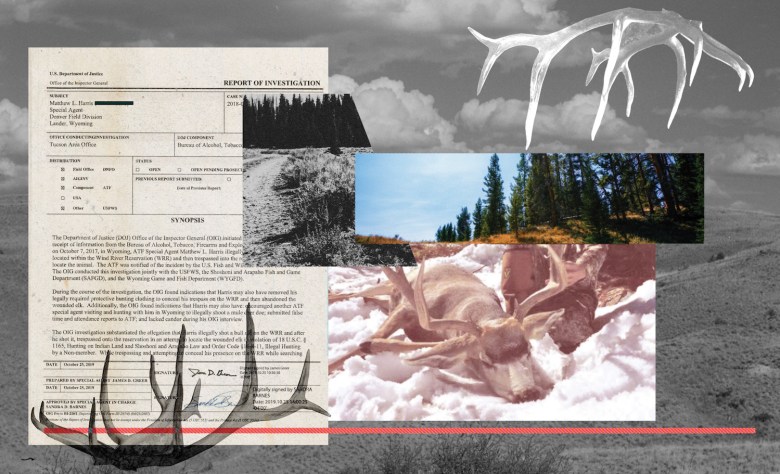 (Neu Tokyo/High Country News)
(Neu Tokyo/High Country News)
In open defiance of the Supreme Court, Wyoming continued to argue that state courts should simply uphold Herrera’s conviction under an old precedent.
“That is not at all what we expected, and it’s highly unfortunate,” said Dan Lewerenz (Ioway), an attorney with the Native American Rights Fund, which represents the Crow Tribe in the ongoing legal battle.
“The state of Wyoming is making superficial arguments to try to bring forward outdated rulings,” Angelique EagleWoman (Dakota), director of the Native American Law and Sovereignty Institute at the Mitchell Hamline School of Law, said. “There is no rational reason (for Wyoming) to not follow the rule of law. It is in fact irrational to waste taxpayers’ money and develop a reputation as reticent to follow the actual law of the United States.”
An appeals court rejected Wyoming prosecutors’ argument, and the state Supreme Court declined to hear the state’s appeal in January, effectively ordering the state to abide by Herrera.
The Wyoming Attorney General’s office declined repeated requests for comment and referred Type Investigations and HCN to Gov. Mark Gordon’s office, which refused interview requests about the state’s legal strategy, but offered a statement.
“Wyoming is currently seeking to address the Supreme Court’s decision while ensuring that all hunting within the state is subject to regulations that support the Governor’s commitment to wildlife conservation in Wyoming,” a governor’s office spokesman wrote in an email.
For treaty hunters, Lewerenz said the state’s legal strategy sends a clear message: If you exercise your right, you should expect to be prosecuted.
“There’s room to talk about Wyoming’s intransigence here,” Lewerenz said. “Why did Wyoming spend two years trying to get the state courts to follow a Supreme Court dissent instead of a Supreme Court majority? Eight years on, why is it so important for them to continue to prosecute Clayvin?”
THE JUSTICE DEPARTMENT’S OFFICE of the Inspector General, or OIG, according to its website, investigates “alleged violations of fraud, abuse and integrity laws that govern DOJ employees.” A Tucson, Arizona-based OIG investigator compiled a report to help the ATF decide whether Harris could keep his job.
Though that report was never made public, the copy HCN obtained reached a conclusion about Harris’ actions after eight pages of evidence.
“The OIG investigation substantiated the allegation that Harris illegally shot a bull elk located on the WRR and after he shot it, trespassed onto the reservation in an attempt to locate the wounded elk,” the report said.
According to the investigator, Harris broke federal, state and tribal laws on Oct. 7, 2017. He encouraged an ATF co-worker to poach a mule deer on public land in 2017 (and, according to the Fish and Wildlife Service report, he may have poached one himself).
Additionally, the investigator found evidence that Harris falsified ATF time and attendance records, once reporting that he’d worked 10 hours on a day he later admitted he was hunting.
But more was needed to charge him with a crime. And by July 3, 2019, nearly two years after the investigation began, the U.S. Attorney’s Office for the District of Wyoming declined to prosecute Harris. Nicole Romine, current chief of that office’s criminal division, cited two problems. First, she said, Michael Kowach’s three sworn witness statements, taken months apart, had some “inconsistencies.”
At least some of those are detailed in a Fish and Wildlife Service report. In October, Kowach told investigators that he never saw the elk Harris shot, but in January, he recalled seeing it bleeding from a wound in its side. The report noted that Kowach was initially “of the opinion” that the elk was on tribal land but later said he was sure of it.
Asked to explain, Kowach told investigators that he’d been scared of turning in a federal cop.
Romine said her office also faced jurisdictional hurdles. The Lacey Act, which federal authorities use to prosecute poaching on tribal land, is, in part, an anti-trespassing statute.
“We could have either prosecuted if we had sufficient evidence that Mr. Harris knowingly and willfully physically trespassed onto Wind River Indian Reservation land to hunt elk, or that he physically trespassed onto the reservation to retrieve that elk,” Romine said.
Since Kowach and Harris agreed that Harris was on national forest when he fired, and in the absence of hard proof that he trespassed onto the reservation afterward, Romine said her office couldn’t act.
Then, in September 2019, the Fremont County Attorney’s Office declined to prosecute Harris for his alleged state-level crimes. Patrick LeBrun, who heads that office, said it wasn’t clear that it had jurisdiction, either.
“A goodly part of it was on the reservation,” LeBrun said, where only the U.S. attorney’s office has criminal jurisdiction over non-Natives.
To the tribal game wardens responsible for preventing poaching on Wind River but lacking criminal jurisdiction, it seemed like federal and state law enforcement were standing in a circle, pointing fingers at each other, while Harris dodged accountability. But Matthew Fletcher, a law professor and director of the Indigenous Law and Policy Center at Michigan State University College of Law, said that the law appeared to have been applied correctly.
“Assuming that what (the U.S. attorney’s office) is saying is true, that does make it pretty close to impossible to prosecute a case,” Fletcher said. Shooting “an animal across boundaries like that probably does not happen very often. It’s almost like the perfect crime.”
Still, according to Fletcher, the fact that Harris’ alleged crime falls into a jurisdictional no man’s land is cause for alarm.
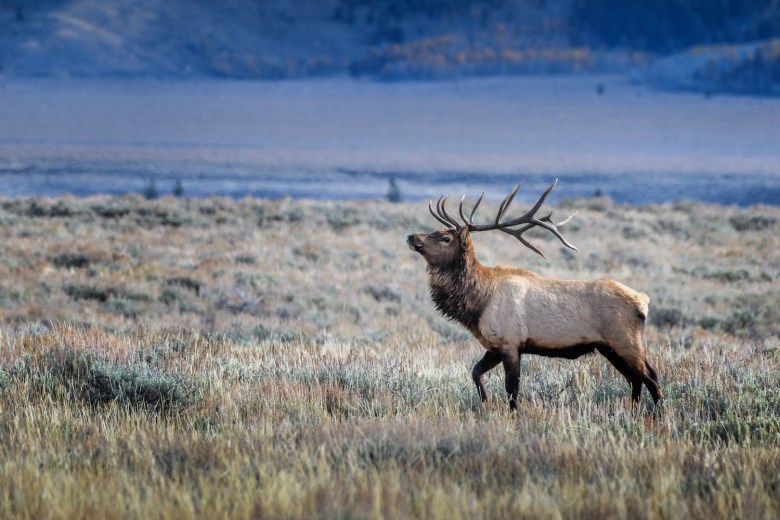 A bull elk in Grand Teton National Park. (Diana Robinson/FlickrCC)
A bull elk in Grand Teton National Park. (Diana Robinson/FlickrCC)
A recent analysis by political scientists at the University of North Texas is the latest to show that federal prosecutors use their declination powers more liberally in cases that originate on tribal land. Between 2006 and 2016, federal prosecutors were 15% more likely to turn down cases originating in Indian Country than cases originating elsewhere.
This is due in part to the jurisdictional questions, which a group of former U.S. attorneys recently condemned as unwieldy and which the federal Indian Law and Order Commission calls an “indefensible morass of complex, conflicting and illogical commands” carried out by outside law enforcement without tribal input or consent.
BY THE TIME HARRIS’ CASE was passed on for civil proceedings to a tribal prosecutor, it had been two years since his alleged crime. Already facing a backlog of cases and with the statute of limitations approaching, she turned it down.
At that point, Art Lawson played his last card: He mailed Matthew Harris a citation and a fine of $650, the highest allowed under the Shoshone and Arapaho Law and Order Code and which Harris was not legally bound to pay. Harris paid swiftly.
“When it comes to wildlife violations, we’re talking about a different socio-economic class of people,” Friday explained.
A non-resident tag to hunt elk in Wyoming can run more than $700, and some hunters might see the Harris case as a bargain.
“We joke that, well, they could give us $1,300 and go for two,” Friday said.
Recently, the department has cracked down; wardens now camp overnight at hotspots during the hunting season and are catching more trespassers before they poach. Still, the imbalance remains. Only federal authorities with criminal authority in these cases can ensure that poaching on the reservation is just as risky as poaching on public land.
“[Herrera] is national news, it’s still in court and everything else,” Lawson said. “Our case didn’t make it anywhere. Nobody’s taking us seriously. But if it’s on the other side of the fence, they sure do.”
Wyoming recently conceded that the Bighorn National Forest is “unoccupied” for the purposes of the Crow Tribe’s treaty rights. If the state is dead set on preserving Herrera’s convictions, it will have to prove that it had a legitimate “conservation necessity” to restrict treaty elk hunting in the area in 2014. And that’s a tall order since, according to the state’s own objectives, the North and South Bighorn elk herds have been overpopulated in recent years.
Should Wyoming decide to change course, blueprints are available: Montana, Idaho and Colorado have all challenged tribes’ off-reservation hunting rights and, when things didn’t go their way, worked with tribes to develop treaty-hunting compacts and regulations. But the damage done to state-tribal relations in this case could be hard to reverse.
As for Harris, he left Wyoming in 2019 and returned to North Carolina. In an email, an ATF spokesperson said she could not comment on “personnel matters or disciplinary actions,” but said that the agency takes allegations of employee misconduct seriously. A receptionist at the Wilmington office confirmed that Harris was employed there in March 2022 and agreed to take a message for him. Harris, however, did not respond.
The case still bothers Justin Friday, who doesn’t mind working through winter nights or sleeping in his truck to prevent similar incidents.
“In some ways, I want to be out here anyway,” Friday said. He’s an outdoorsman and spends a lot of his free time in the Wind River’s wilderness, too.
Sometimes, Friday said, the biting cold rouses him from sleep and he has to run his truck’s heater to get comfortable. This is how he guards the reservation’s natural resources, knowing that if he doesn’t fend off would-be poachers, they won’t be held accountable.
“That’s my job, to go out there and catch them,” Friday said. “My frustration comes when I catch them and nobody does anything.”
This piece was originally published in High Country News. It was produced in partnership with Type Investigations.
The post Who does the state of Wyoming consider a poacher? appeared first on wyomingdigest.com.





